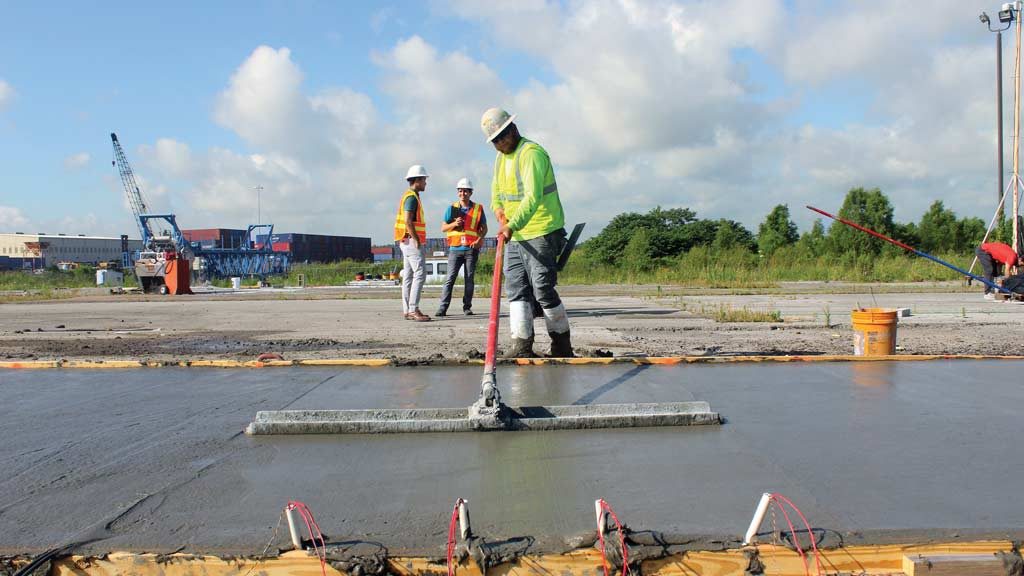Concrete is often the building material of choice for construction projects because of its toughness, durability and the fact it can bear heavy loads. However, the cementitious mixture has an Achilles Heel in the form of lower tensile strength which can lead to cracking under excessive bending.
A team of researchers at Louisiana State University (LSU) in the U.S. has been tackling the problem for the better part of two years and is now testing a new, cost-effective, bendable concrete blend for mass market that uses readily-available ingredients and has more flexural strength.
The researchers, led by Gabriel Arce, senior research associate in the university’s department of construction management, have come up with a new Engineered Cementitious Composite, or ECC material, that can withstand the kind of deformation stress that would crack regular concrete.
“Compared to typical concrete our cost-effective ECC material has about 300 times more deformation capacity, more than two times the flexural strength and a higher compressive strength,” said Arce.
“The cost of our material is approximately 3.5 times that of regular concrete. However, when you factor in the possibility of building pavements at half the thickness and the enhanced construction productivity due to the ability to construct pavements without joints, the cost of pavements with our ECC material could be comparable to that of traditional concrete pavements.”
Conventional concrete is made by mixing sand, cement and aggregates and activating it by adding water. It typically has steel reinforcing bars running through it for added tensile strength and to reduce cracking.
ECC, on the other hand, is a composite reinforced with short, random polyvinyl fibers eight to 12 millimetres long and about 40 microns in diameter, about half the thickness of a human hair. The fibers have a surface coating that allows them to slip rather than break under heavy loads, making the material more flexible.
The result is a mix that acts more like ductile metal material than brittle glass, allowing it to be used in a variety of applications.
LSU researchers began by doing preliminary tests on four different types of sand, two different types of recycled crumb rubber materials, five different types of fiber, and three different types of fly ash.
Once the raw ingredients with the best potential were determined, several ECC mix designs were comprehensively evaluated for compressive strength, tensile toughness, deformation capacity, flexural performance, workability, cracking properties, and then refined based on testing outcomes.
More than 30 different mix designs were evaluated over a year-long period by the team of researchers.
The final LSU mix uses fine sand from the Mississippi River, rather than expensive and hard-to-obtain micro silica, and a polyvinyl alcohol (PVA) fiber that is readily available in the U.S. market. Much of the conventional cement used in the ECC has been replaced with locally available fly ash. The PVA does not possess the oil-coating that is typically used in PVA fibers for ECC application, which complicates the ability to endow the concrete with a ductile behaviour and makes the design of the material more challenging, but it substantially reduces the cost and increases practicality.
“After this process, we were able to manufacture ECC materials with locally available ingredients that produced excellent mechanical properties and were economical,” said Arce.
Up to 75 per cent of cement in the bendable mix was replaced with fly ash, making it less expensive.
While the material does not exhibit better mechanical properties than typical ECC, Arce said it is more practical because it uses readily available, locally-sourced ingredients at a fraction of the price.
Admittedly, said Arce, the mix is much more expensive than regular concrete, which might not sound economically feasible at first, but only half as much material is needed to perform the same function.
Therefore, the material can reduce the cost because it has the potential to provide more durable and reliable concrete pavements that can mitigate the necessity of recurring repair, saving time and money.

Arce said the research is important because ECCs are promising for repair and construction of transportation infrastructure, along with pavements and overlays.
For instance, he said, ECC’s exceptional ductility has the potential to eliminate the need for joints, reducing construction and repair costs, and prevent fracture of concrete pavements. Further, ECC pavements could potentially be constructed at half the thickness of typical concrete pavements.
The material has been used to repair two sidewalks on the LSU campus, mainly to prove that the material is easy to place and finish and can have superior durability to typical concrete at half the thickness. Arce says the sidewalks are regularly inspected and no signs of deterioration have been observed.
A large-scale test of the new material is now under way at the Department of Transportation and Development’s Pavement Research Facility in Baton Rouge.
A 120-foot-long section of ECC and a 60-foot-long section of regular concrete have been laid and an Accelerated Transportation Loading System, or ATLaS 30, equipment capable of compressing many years of road wear into a few months, is being used to test the two lengths to obtain data on the overlays.
An evaluation of the results is scheduled for later this year.
Arce has high hopes of bringing the material to market — not this year, but down the road.
He and his team are still working on improving the cost-effectiveness and performance of the ECC material.
Currently, the team is experimenting with adding waste products from the local sugar industry in the ECC composition.
“To date, results are promising,” he said. “If the successful development of this material continues it will hopefully be able to hit the market in the coming years.”




Recent Comments